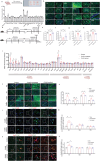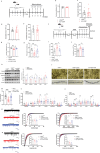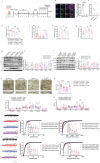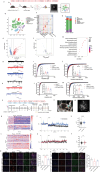Microglia-Derived Vitamin D Binding Protein Mediates Synaptic Damage and Induces Depression by Binding to the Neuronal Receptor Megalin
- PMID: 39716879
- PMCID: PMC11809382
- DOI: 10.1002/advs.202410273
Microglia-Derived Vitamin D Binding Protein Mediates Synaptic Damage and Induces Depression by Binding to the Neuronal Receptor Megalin
Abstract
Vitamin D binding protein (VDBP) is a potential biomarker of major depressive disorder (MDD). This study demonstrates for the first time that VDBP is highly expressed in core emotion-related brain regions of mice susceptible to chronic unpredictable mild stress (CUMS). Specifically, the overexpression of microglia (MG)-derived VDBP in the prelimbic leads to depression-like behavior and aggravates CUMS-induced depressive phenotypes in mice, whereas conditional knockout of MG-derived VDBP can reverse both neuronal damage and depression-like behaviors. Mechanistically, the binding of MG-derived VDBP with the neuronal receptor megalin mediates the downstream SRC signaling pathway, leading to neuronal and synaptic damage and depression-like behaviors. These events may be caused by biased activation of inhibitory neurons and excitatory-inhibitory imbalance. Importantly, this study has effectively identified MG-derived VDBP as a pivotal mediator in the interplay between microglia and neurons via its interaction with the neuronal receptor megalin and intricate downstream impacts on neuronal functions, thus offering a promising therapeutic target for MDD.
Keywords: depression; megalin; microglia; neuron damage; vitamin D binding protein.
© 2024 The Author(s). Advanced Science published by Wiley‐VCH GmbH.
Conflict of interest statement
The authors declare no conflict of interest.
Figures






Similar articles
-
hUC-MSCs ameliorated CUMS-induced depression by modulating complement C3 signaling-mediated microglial polarization during astrocyte-microglia crosstalk.Brain Res Bull. 2020 Oct;163:109-119. doi: 10.1016/j.brainresbull.2020.07.004. Epub 2020 Jul 15. Brain Res Bull. 2020. PMID: 32681971
-
SRC-1 Deficiency Increases Susceptibility of Mice to Depressive-Like Behavior After Exposure to CUMS.Neurochem Res. 2021 Jul;46(7):1830-1843. doi: 10.1007/s11064-021-03316-y. Epub 2021 Apr 21. Neurochem Res. 2021. PMID: 33881662
-
p75NTR mediated chronic restraint stress-induced depression-like behaviors in mice via hippocampal mTOR pathway.Life Sci. 2024 Dec 1;358:123175. doi: 10.1016/j.lfs.2024.123175. Epub 2024 Oct 28. Life Sci. 2024. PMID: 39477145
-
Altered N-linked glycosylation in depression: A pre-clinical study.J Affect Disord. 2024 Aug 15;359:333-341. doi: 10.1016/j.jad.2024.05.118. Epub 2024 May 25. J Affect Disord. 2024. PMID: 38801920
-
The formative role of microglia in stress-induced synaptic deficits and associated behavioral consequences.Neurosci Lett. 2019 Oct 15;711:134369. doi: 10.1016/j.neulet.2019.134369. Epub 2019 Aug 15. Neurosci Lett. 2019. PMID: 31422099 Free PMC article. Review.
Cited by
-
The regulatory variant rs1950834 confers the risk of depressive disorder by reducing LRFN5 expression.BMC Med. 2025 May 30;23(1):316. doi: 10.1186/s12916-025-04141-8. BMC Med. 2025. PMID: 40442660 Free PMC article.
References
-
- Shi Y., Song R., Wang L., Qi Y., Zhang H., Zhu J., Zhang X., Tang X., Zhan Q., Zhao Y., Swaab D. F., Bao A.‐M., Zhang Z., J. Affective Disord. 2020, 277, 620. - PubMed
MeSH terms
Substances
Grants and funding
- 2022ZD0211701/China Science and Technology Innovation 2030 - Major Project
- 2021ZD0200700/China Science and Technology Innovation 2030 - Major Project
- 82130042/National Natural Science Foundation of China
- 81830040/National Natural Science Foundation of China
- 82371532/National Natural Science Foundation of China
- GJHZ20210705141400002/Shenzhen Science and Technology Serial Funds
- KCXFZ20211020164543006/Shenzhen Science and Technology Serial Funds
- JCYJ20220818101615033/Shenzhen Science and Technology Serial Funds
- ZDSYS20220606100606014/Shenzhen Science and Technology Serial Funds
- KQTD20221101093608028/Shenzhen Science and Technology Serial Funds
LinkOut - more resources
Full Text Sources
Medical
Miscellaneous
